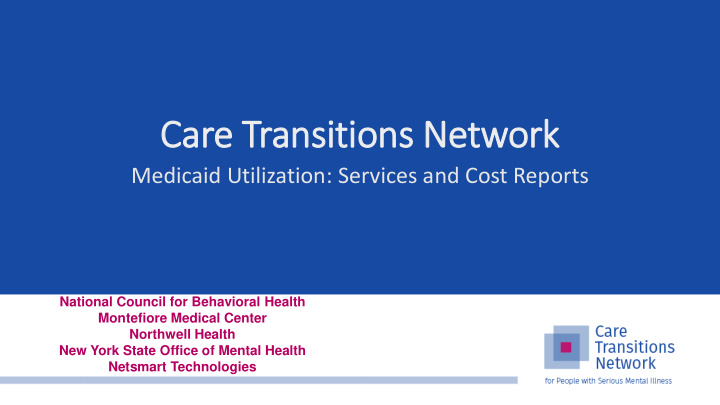



Care Transitions Network Medicaid Utilization: Services and Cost Reports National Council for Behavioral Health Montefiore Medical Center Northwell Health New York State Office of Mental Health Netsmart Technologies
Your Presenters Today Zana Fejza Provider Relations Analyst Montefiore Care Management Frederick Stanley Assistant Director, Behavioral Health Reporting and Analytics Montefiore Care Management Maura Gaswirth, LICSW Director, Training and Technical Assistance The National Council for Behavioral Health
Total Healthcare Costs of Your Behavioral Health Medicaid Population 3
CMS Change Package: Primary and Secondary Drivers Patient and Family- 1.1 Patient & family engagement Centered Care 1.2 Team-based relationships Design 1.3 Population management 1.4 Practice as a community partner 1.5 Coordinated care delivery 1.6 Organized, evidence-based care 1.7 Enhanced access Continuous, Data- 2.1 Engaged and committed leadership Driven Quality 2.2 QI strategy supporting a culture of quality and safety Improvement 2.3 Transparent measurement and monitoring 2.4 Optimal use of HIT Sustainable 3.1 Strategic use of practice revenue Business 3.2 Staff vitality and joy in work Operations 3.3 Capability to analyze and document value 3.4 Efficiency of operation
Report Methodology July 2017 Report Current April 2018 Report • Medicaid Data Warehouse • Medicaid Data Warehouse (MDW) (MDW) • Clients with 1+ paid service • Clients with 1+ BH paid service • Organization level • Practice setting/NPI level • RY’s: 2016, 2015, 2014 • RY: 2016 • Report threshold • Report threshold • Population 150+ clients • Population 100+ clients • Redactions < 30 clients • Redactions < 30 clients *Practice setting logic is closely aligned with PSYCKES (OMH)
Introduction to Report • Organization & practice name (might not be site-specific) • Practice setting: • Rate code driven (i.e., Clinic-MH based on OMH rate codes) • NPI’s: in practice and affiliate providers • Inclusions : Medicaid active adults 18-64 years old with at least one paid BH service in 2016 • Exclusions : Minors, age 65+, dual eligible (Medicare/Medicaid), primary diagnosis of dementia and developmental disabilities
Report Review Population, Health Plans, Total Outpatient MH & SU Visits at Provider • Population • Client count • Months of active Medicaid • Behavioral Health Programs • Client counts • Rate code • Health Plan • Fee-for- Service in “Other HP” • Total MH & SU Visits • MH: includes PROS • SU: methadone visits undercounted
Report Population
Report Review Outpatient Services • Outpatient services by categories of service • Visits per 1000 members • Benchmarking • Clinic-MH, Clinic-SU, Inpatient- MH and Inpatient-SU • Network-wide mean • PMPM: Per Member Per Month • Top 3 providers • Medical • Behavioral health
Outpatient Services
Report Review Hospitalization • Hospitalization by category • Average LOS • Discharges per 1000 members • Days per 1000 members • Benchmark • Top 3 providers • Medical • Behavioral health
Hospitalization
Pharmacy and ER Visits • Pharmacy – RX per 1000 members • Includes refills • ER Visits – exclude conversions • Visits per 1000 members • Medical and BH costs • Proportion of costs for medical and BH • Clients with > ED visits for medical and BH
Additional Services
PMPM Breakdown
Questions?
What’s Next • Review your report and reference guide with your team • Schedule a call with your Practice Coach • Review Upcoming Technical Assistance to Support your Work • MTM Services Free Consultation Packages • Same-Day Access and Just-in-Time Prescribing • Cost and Revenue Analysis • SPQM Quality Management • Value-based Payment Arrangement Contracting Webinar Series • Practice Transformation Academy • Increased Incentive Payment
Thank you! www.CareTransitionsNetwork.org CareTransitions@TheNationalCouncil.org The project described was supported by Funding Opportunity Number CMS-1L1-15-003 from the U.S. Department of Health & Human Services, Centers for Medicare & Medicaid Services. Disclaimer: The contents provided are solely the responsibility of the authors and do not necessarily represent the official views of HHS or any of its agencies.
Recommend
More recommend